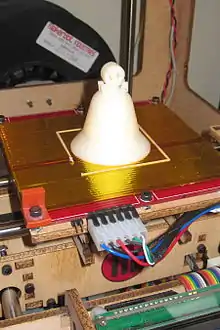Acrylonitrile butadiene styrene
Acrylonitrile butadiene styrene (ABS) (chemical formula (C8H8)x·(C4H6)y·(C3H3N)z) is a common thermoplastic polymer. Its glass transition temperature is approximately 105 °C (221 °F).[4] ABS is amorphous and therefore has no true melting point.
 Monomers in ABS polymer | |
.jpg.webp) ABS polymer grains | |
| Identifiers | |
|---|---|
| ChemSpider |
|
| ECHA InfoCard | 100.127.708 |
PubChem CID |
|
CompTox Dashboard (EPA) |
|
| Properties | |
| (C8H8·C4H6·C3H3N)n | |
| Density | 1.060–1.080 g/cm3[1] |
| Insoluble in water | |
| Related compounds | |
Related compounds |
Acrylonitrile, butadiene and styrene (monomers) |
Except where otherwise noted, data are given for materials in their standard state (at 25 °C [77 °F], 100 kPa). | |
| Infobox references | |
| Acrylonitrile butadiene styrene
| |
|---|---|
| Physical properties | |
| Density (ρ) | 0.9–1.53 g/cm3; median, 1.07 g/cm3 |
| Flammability | 1.00 |
| Thermal properties | |
| Thermal conductivity (k) | 0.1 W/(m·K) |
| Linear thermal expansion coefficient (α) | 12×10−5 K−1 |
| Chemical resistance | |
| Acids—concentrated | Good |
| Acids—dilute | Excellent |
| Alcohols | Poor |
| Aldehydes | Poor |
| Alkalis | Excellent |
| Aromatic hydrocarbons | Poor |
| Esters | Poor |
| Halogenated hydrocarbons | Poor |
| Ketones | Poor |
| [2][3] | |
ABS is a terpolymer made by polymerizing styrene and acrylonitrile in the presence of polybutadiene. The proportions can vary from 15% to 35% acrylonitrile, 5% to 30% butadiene and 40% to 60% styrene. The result is a long chain of polybutadiene criss-crossed with shorter chains of poly(styrene-co-acrylonitrile). The nitrile groups from neighboring chains, being polar, attract each other and bind the chains together, making ABS stronger than pure polystyrene. The acrylonitrile also contributes chemical resistance, fatigue resistance, hardness, and rigidity, while increasing the heat deflection temperature. The styrene gives the plastic a shiny, impervious surface, as well as hardness, rigidity, and improved processing ease. The polybutadiene, a rubbery substance, provides toughness and ductility at low temperatures, at the cost of heat resistance and rigidity.[3] For the majority of applications, ABS can be used between −20 and 80 °C (−4 and 176 °F), as its mechanical properties vary with temperature.[5] The properties are created by rubber toughening, where fine particles of elastomer are distributed throughout the rigid matrix.
Properties
ABS provides favorable mechanical properties such as impact resistance, toughness, and rigidity when compared with other common polymers.[3] A variety of modifications can be made to improve impact resistance, toughness, and heat resistance. The impact resistance can be amplified by increasing the proportions of polybutadiene in relation to styrene and also acrylonitrile, although this causes changes in other properties. Impact resistance does not fall off rapidly at lower temperatures. Stability under load is excellent with limited loads. Thus, by changing the proportions of its components, ABS can be prepared in different grades. Two major categories could be ABS for extrusion and ABS for injection molding, then high and medium impact resistance. Generally ABS would have useful characteristics within a temperature range from −20 to 80 °C (−4 to 176 °F).[5]


The final properties will be influenced to some extent by the conditions under which the material is processed to the final product. For example, molding at a high temperature improves the gloss and heat resistance of the product whereas the highest impact resistance and strength are obtained by molding at low temperature. Fibers (usually glass fibers) and additives can be mixed in the resin pellets to make the final product strong and raise the maximum operating temperature as high as 80 °C (176 °F). Pigments can also be added, as the raw material original color is translucent ivory to white. The aging characteristics of the polymers are largely influenced by the polybutadiene content, and it is normal to include antioxidants in the composition. Other factors include exposure to ultraviolet radiation, which additives are also available to protect against.
ABS polymers are resistant to aqueous acids, alkalis, concentrated hydrochloric and phosphoric acids, alcohols and animal, vegetable and mineral oils, but they are swollen by glacial acetic acid, carbon tetrachloride and aromatic hydrocarbons and are attacked by concentrated sulfuric and nitric acids. They are soluble in esters, ketones (such as acetone), chloroform, and ethylene dichloride.[6] They also offer poor resistance to chlorinated solvents and aldehydes.[3]
Even though ABS plastics are used largely for mechanical purposes, they also have electrical properties that are fairly constant over a wide range of frequencies. These properties are little affected by temperature and atmospheric humidity in the acceptable operating range of temperatures.[7]
ABS is flammable when it is exposed to high temperatures, such as those of a wood fire. It will melt and then boil, at which point the vapors burst into intense, hot flames. Since pure ABS contains no halogens, its combustion does not typically produce any persistent organic pollutants, and the most toxic products of its combustion or pyrolysis are carbon monoxide and hydrogen cyanide.[8] ABS is also damaged by sunlight. This caused one of the most widespread and expensive automobile recalls in US history due to the degradation of the seatbelt release buttons.[9][10]
ABS can be recycled, although it is not accepted by all recycling facilities.[11][12]
ABS is one of many types of thermoplastic with biomedical applications, with injection-molded components being easy to manufacture for single-use. It can be sterilized by gamma radiation or ethylene oxide (EtO).[13]
| Property | Value |
|---|---|
| Young's Modulus (GPa) | 2.28 |
| Tensile Strength (MPa) | 43 |
| Fluxural modulus (GPa) | 2.48 |
| Fluxural Strength (MPa) | 77 |
| Notched Izod (kJ/m) | 0.203 |
| Heat Deflection Temperature, 1.81 MPa, (C) | 81 |
Production
ABS is derived from acrylonitrile, butadiene, and styrene. Acrylonitrile is a synthetic monomer produced from propylene and ammonia; butadiene is a petroleum hydrocarbon obtained from the C4 fraction of steam cracking; styrene monomer is made by dehydrogenation of ethyl benzene — a hydrocarbon obtained in the reaction of ethylene and benzene.
ABS combines the strength and for its hardness, gloss, toughness, and electrical insulation properties.
According to the European plastic trade association PlasticsEurope, industrial production of 1 kg (2.2 lb) of ABS resin in Europe uses an average of 95.34 MJ (26.48 kW⋅h) and is derived from natural gas and petroleum.[14][15]
Machining
ABS is manufactured in a variety of grades, but for precision machining of ABS structural parts, it is recommended to use Machine Grade ABS. Machine Grade ABS is easily machined via standard machining techniques including; turning, drilling, milling, and sawing. For heat-bending and thermoformed parts, use ABS Forming Grade. [16] ABS can be chemically affixed to itself and other like plastics.[17]
Applications

ABS's light weight and ability to be injection molded and extruded make it useful in manufacturing products such as drain-waste-vent (DWV) pipe systems. Musical instruments such as recorders, plastic oboes and clarinets, piano movements, and keyboard keycaps are commonly made out of ABS.[18]
Other uses include golf club heads (because of its good shock absorbance), automotive trim components, automotive bumper bars, binoculars, inhalers, monoculars, nebulizers,[19] non-absorbable sutures, tendon prostheses, drug-delivery systems tracheal tubes,[13] enclosures for electrical and electronic assemblies (such as computer cases), protective headgear, whitewater canoes, buffer edging for furniture and joinery panels, luggage and protective carrying cases, pen housing, and small kitchen appliances. Toys, including LEGO and Kre-O bricks, are a common application.[20][21]
Household and consumer goods comprise the major applications of ABS.[22]
ABS plastic ground down to an average diameter of less than 1 micrometer is used as the colorant in some tattoo inks.[23]
When extruded into a filament, ABS plastic is a common material used in 3D printers.[24]
When it is used as a filament for the 3D printing by fused deposition modeling, it is suitable due to the high stability and various post-processing options (sanding, painting, gluing, filling), especially for the production of prototypes. Particular forms of ABS filaments are ABS-ESD (electrostatic discharge) and ABS-FR (fire resistant), which are used in particular for the production of electrostatically sensitive components and refractory prefabricated parts.
Hazard for humans
ABS is stable to decomposition under normal use and polymer processing conditions with exposure to carcinogens well below workplace exposure limits.[25] However, at higher temperatures at or above 400 °C (750 °F) ABS can decompose into its constituents: butadiene (carcinogenic to humans), acrylonitrile (possibly carcinogenic to humans), and styrene (reasonably anticipated to be a human carcinogen).[25][26]
Ultrafine particles (UFPs) may be produced at lower temperatures during the 3D printing process.[27] Concerns have been raised regarding airborne UFP concentrations generated while printing with ABS, as UFPs have been linked with adverse health effects.[28]
See also
- Novodur
- Polylactic acid (PLA)—also used for 3D printing
References
- "Matbase". Archived from the original on 17 June 2014. Retrieved 3 July 2014.
- "Chemical & Environmental Resistance of Thermoplastics". rtpcompany.com.
- Peters, Edward N., "Plastics: Thermoplastics, Thermosets, and Elastomers", Handbook of Materials Selection, New York: John Wiley & Sons, Inc., pp. 363–365
- ABS. Prospector (2016).
- Plastic Properties of Acrylonitrile Butadiene Styrene (ABS). Archived May 15, 2010, at the Wayback Machine. Small table of ABS properties towards the bottom. Retrieved 7 May 2010.
- Benj Edwards Vintage Computing and Gaming | Archive » Why Super Nintendos Lose Their Color: Plastic Discoloration in Classic Machines. Vintagecomputing. January 12, 2007
- Harper C.A. (1975) Handbook of plastic and elastomers, McGraw-Hill, New York, pp. 1–3, 1–62, 2–42, 3–1, ISBN 0070266816
- Rutkowski, J. V.; Levin, B. C. (1986). "Acrylonitrile-butadiene-styrene copolymers (ABS): Pyrolysis and combustion products and their toxicity?a review of the literature". Fire and Materials. 10 (3–4): 93. doi:10.1002/fam.810100303.
- Henshaw, J. M.; Wood, V.; Hall, A. C. (1999). "Failure of automobile seat belts caused by polymer degradation". Engineering Failure Analysis. 6: 13–25. doi:10.1016/S1350-6307(98)00026-0.
- "Belts recalled in 8.4 million vehicles". The Baltimore Sun. Knight-Ridder News Service. May 24, 1995. Retrieved November 16, 2015.
- "ABS Recycling". Heathland B.V. Archived from the original on 2014-03-06. Retrieved 2013-12-31.
- "Recycling plastic". Brisbane City Council. Retrieved 2013-12-31.
- Nancy Crotti. "These common thermoplastics are ideal for medical device injection molding". MedicalDesign&Outsourcing. MedicalDesign&Outsourcing. Retrieved May 4, 2020.
- Boustead, I (March 2005). Acrylonitrile-Butadiene-Styrene Copolymer (ABS) (Technical report). Eco-profiles of the European Plastics Industry. PlasticsEurope. Archived from the original on 2011-05-30. Retrieved 2013-01-23.
- Hammond, G. P.; Jones, C. I. (2008). "Embodied energy and carbon in construction materials" (PDF). Proceedings of the ICE – Energy. 161 (2): 87. doi:10.1680/ener.2008.161.2.87.
- "ABS Sheet - ABS Rod (Machine Grade ABS)". Professional Plastics. Professional Plastics. Retrieved Feb 3, 2021.
- "ABS Plastic Sheet, Rod, Tube and Accessories". Interstate Plastics. Interstate Plastics. Retrieved September 23, 2016.
- "Keycap Construction: ABS". Deskthority. September 2014.
- "Acrylonitrile Butadiene Styrene (ABS) and its Features". Omnexus. Omnexus. Retrieved May 4, 2020.
- ABS – acrylonitrile butadiene styrene on Designsite.dk, lists applications. Retrieved 27 October 2006.
- May, James (2009). James May's Toy Stories. London: Conway. ISBN 978-1-84486-107-1.
- Market Study Engineering Plastics, Ceresana, September 2013.
- Kennedy, C.T.C.; et al. (2010), "Mechanical and Thermal Injury", in Tony Burns; et al. (eds.), Rook's Textbook of Dermatology, 2 (8th ed.), Wiley-Blackwell, p. 28.48
- "The Free Beginner's Guide". www.3dprintingindustry.com. 3D Printing Industry. Retrieved 30 May 2016.
- Unwin, John (2013). "Airborne emissions of carcinogens and respiratory sensitizers during thermal processing of plastics". Annals of Occupational Hygiene. 57 (3): 399–406. doi:10.1093/annhyg/mes078. PMID 23091110.
- "National Academy of Sciences strongly affirms science showing styrene is a human carcinogen". Richard Denison. Environmental Defense Fund. July 29, 2014. Retrieved February 6, 2021.
- Azimi, Parham; Zhao, Dan; Pouzet, Claire; Crain, Neil E.; Stephens, Brent (2016). "Emissions of Ultrafine Particles and Volatile Organic Compounds from Commercially Available Desktop Three-Dimensional Printers with Multiple Filaments". Environmental Science & Technology. 50 (3): 1260–1268. Bibcode:2016EnST...50.1260A. doi:10.1021/acs.est.5b04983. ISSN 0013-936X. PMID 26741485.
- Stephens, Brent (November 2013). "Ultrafine particle emissions from desktop 3D printers". Atmospheric Environment. 79: 334–339. Bibcode:2013AtmEn..79..334S. doi:10.1016/j.atmosenv.2013.06.050.
External links
| Wikimedia Commons has media related to Acrylonitrile butadiene styrene. |